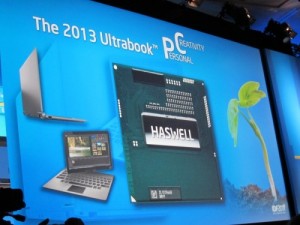The company Intel is showing off its department R & D with the next generation of chips Intel Haswell. This is the natural evolution process in the tick / tock of the company which changes the internal architecture while maintaining the 22 nm manufacturing process of Ivy Bridge.
Intel Haswell cycle corresponds to the ‘tock’ of evolution of processors and chip giant’s platforms and is also present in other areas of computer hardware will be the basis of the third generation of Ultrabooks. Made of 22-nanometer process technology will mean the biggest performance boost from the arrival of the Core 2 Duo in 2006.
One of the biggest improvements will come from the new instructions AVX 2.0 (Advanced Vector Extensions) with SIMD register width increased to 256-bits, new features, instructions FMA3 (Fused Multiply-Add) and a new coding scheme, increasing management Vector data packets and the use of more threads and processor cores.
The AVX 2.0 together with the Intel Haswell New Instructions (HNI) will improve the performance of applications and operating systems like Windows 7 Professional.
Another important point Intel Haswell will be increasing integration into the same die with the greatest number of components which together with “low-power states” will reduce their consumption and thereby improve the autonomy, one aspect worth Ultrabooks.
To highlight the new generation integrated graphics that Intel will include in Intel Haswell with a large increase in power (up to triple in 3D graphics) against Ivy Bridge. It also improves the ability of overclocking, an exclusive L4 cache and native support for new instructions from Microsoft Direct X 11.1. Be offered in three versions GT1, GT2 and GT3 chosen depending on the processor and the computer it is intended.
Similarly, Intel microprocessors will offer different models of dual or quad core with different levels of work rate, the fastest exceeding 4 GHz ultra-low voltage a variant for Ultrabooks requiring maximum autonomy will consume 15 watts very small considering that include dual-core processing GPU and memory controller.
To Intel Haswell, Intel has created two socket, the G3 (947 pins) for laptops and H3 (LGA1150) for desktop computers. Also several chipsets Lynx Point HM87, HM85/HM80, QM87 and a low-power chipset focused ultrabooks known as UM83.
Will support technologies such as Intel Smart Response technology (SSD caching) and RAID natively. Caching allows a unified SSD SSD and HD as a single unit providing the speed of the SSD for files used while obtaining access to the full capacity hard disk dl.
Another improvement will come from the hand of support for DDR4 memory to 2133 MHz in configuration quad-channel.
Pay attention to market developments in the coming years we will see Intel Haswell in 2013 and in most ultrabooks, laptops and tablet Windows 8 so indisputable.
